▶ Taste of Shanghai
Shanghai cuisine, also known as Hu cuisine, is a popular style of Chinese food. In a narrow sense, Shanghai cuisine refers only to what is traditionally called Benbang cuisine which originated in Shanghai. In a broader sense, it refers to complex styles of cooking developed under the influence of neighboring Jiangsu and Zhejiang provinces.The dishes within the cuisine need to master the three elements of "color, aroma, and taste" (色香味). Like other cuisines within China, Shanghai cuisine emphasizes the use of seasonings, the quality of raw ingredients, and preserving the original flavors of ingredients. The adoption of Western influence in Shanghai cuisine resulted in a unique cooking style known as Haipai cuisine (海派菜).
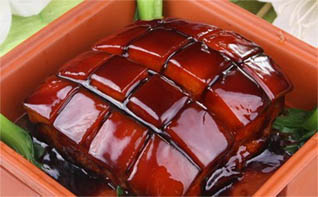
Red braise or Hongshao in Chinese is a typical Chinese way to cook meat, and Shanghainese are good at cooking pork belly in the way of Hongshao. The brown color comes from the slow-cooking soy bean sauce mixed with caramelized sugar. If visiting Zhujiajiao water town, outskirts of Shanghai, the red braised pork is a must-order dish.

The special feature of this delicious dish is stuffing 8 indispensable ingredients (including bamboo shoots, dried scallops, sticky rice, minced pork, Mandarin mushrooms, mixed nuts, chestnuts and duck gizzards) into the duck's belly, then simmer until the flavors are absorbed. The finished product is soft, melts in the mouth, has an attractive golden color and is extremely nutritious.

Having a history of more than half a century, Pork Chop with rice cake is a local specialty, and the deep-fried pork chop pairs well with the rice cakes. It is a common dish for lunch. Both the ribs and rice cakes are deep fried. The pork chop is coated in a sweet and sticky soy-based sauce and the rice cakes are soft and slightly chewy.
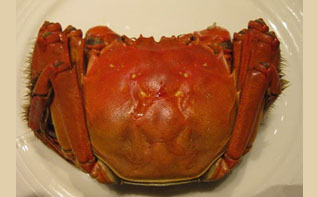
Just as Peking duck is iconic to Beijing, the hairy crab is iconic to Shanghai. In autumn, it is a tradition for Shanghai people to buy hairy crabs and enjoy them with family. Steam and unwrap the crabs, crack the shell, and extract the meat from the shells. Enjoying simply steamed hairy crabs brings joy and laughter to the whole family and they always come with vinegar, soy bean sauce, ginger, and scallions.
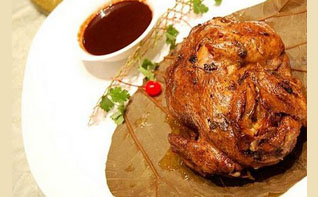
This unique cooking technique produces tender, juicy, and aromatic chicken, with the original taste of the chicken perfectly retained and trapped. The bones just fall off the chicken after hours of baking, and the meat is bursting with flavor and fragrance. A popular restaurant on the Bund is highly recommended for trying Beggar's Chicken.

Drunken Chicken is a popular local dish in Shanghai. The steamed chicken is chopped to small pieces and preserved overnight with strong Chinese baijiu or other liquors. The next day, the cold chicken is done, and it’s always served with chili sauce, vinegar, and other sauces. A special cooking method that cooled the boiled chicken in cold water helped retain its flavor and luster, and also crisped its skin.

Are you a meat eater? You will like the “Lion head”. It is a giant meatball surely smaller than the lion’s head but much like the size of a fist. It is very delicious, creamy, bathed in savory broth with some vegetables. It is very porky and delicately presented with an irresistible, delightful aroma. It is one of the representative dishes in Shanghai.

Shanghai Snacks include nanxiang steamed buns 南翔小笼包; large soup buns 灌汤包; vegetarian stuffed buns 素菜包; Niangao or New Year cake; eyebrow-shaped shortcake 眉毛酥; crab shell cake 蟹壳黄. Shanghai snacks are dainty and exquisite in shape with unique features.

Osmanthus cake (Chinese: 桂花糕) is a traditional sweet-scented Chinese pastry made with glutinous rice flour, honey, sweet-scented osmanthus and rock sugar. It has a translucent, sweet, and soft, waxy texture.
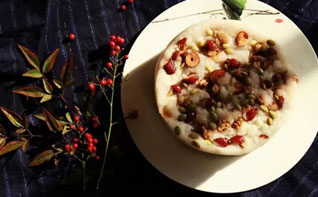
Chongming Gao, or Chongming Cake, is a traditional Shanghai pastry in Chongming district. This sweet and tender treat is made with glutinous and non-glutinous rice that's mashed, mixed, and then steamed with sugar, red beans, dates, candied fruits, pine nuts, melon seeds and assorted dried fruits.
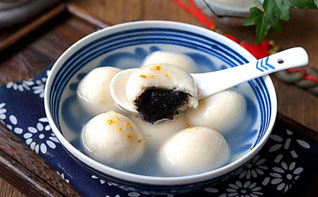
Tangyuan are a traditional Chinese dessert made of glutinous rice shaped into balls that are served in a hot broth or syrup. They come in varying sizes, anything between a marble to a ping-pong ball, and are sometimes stuffed with filling.
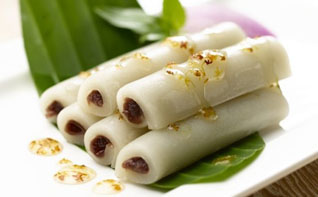
Traditional pastries, including green rice balls (qingtuan), sticky rice cake bars (tiaotougao), and longevity peach buns (shoutao), hold not only culinary appeal but also rich cultural significance. Tiaotougao is the most iconic — a long, slender rice cake bar with slightly firm edges and a pleasantly chewy texture.
Recommended Food Streets:
-Yu Garden Food Street (豫园美食街): Snacks such as Nanxiang mantou, Ningbo dumplings, and eight-treasure rice pudding are available; you can take No. 11, 66, 71 buses to reach here.-Yellow River Food Street (黄河路美食街): When night falls, seafood restaurants are drawing you with its alluring smell and vibrant neon lights; you can take No. 15, 19, 20, 21, 27, 37, 315 buses to reach here.
-Zhapu Road Food Street (乍浦路美食街): it stretches about one kilometers long and boasts Cantonese, Sichuan, and Jiangsu, Zhejiang, Shanghai cuisines; you can take No. 13, 17, 65, 100, 305, 308 buses to reach here.
-Chenghuangmiao (City God Temple) (老城隍庙): It has a long history of snacks, dating back to Ming Dynasty. It attracts people because of its quaint architecture as well as delicious food. It has been said that forty batches of head of states so far.
- Hongji Square (弘基广场): Here, visitors can try some traditional western food, especially fast food. Some popular tea houses, noodle shops, coffee houses are here and there.
-Wujiang Road(吴江路): It is a good place for medium-income common people. It's a great place to enjoy delicious food without breaking the bank.
-Yunnan Road (中餐老街云南路): It is an old food street in Shanghai, attracting diners from home and abroad, making it rare to find some western or modern restaurants or hotels. Shanghai cuisine and Sichuan cuisine enjoy a great popularity here; you can take No. 17, 18, 23, 42, 71, 775, 782, 783 buses to reach here.
